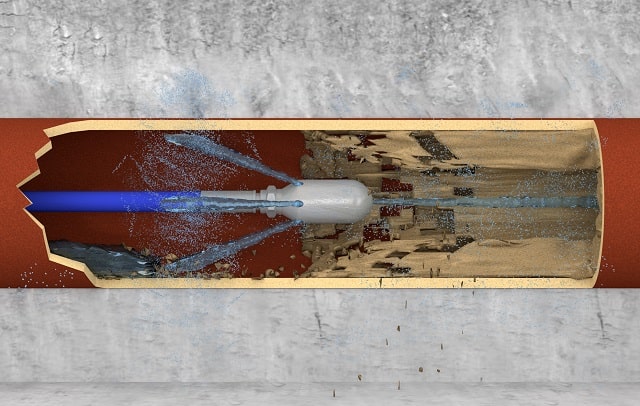
Every year, US water treatment facilities deal with 23,000 to 75,000 sanitary sewer overflows. Unfortunately, these overflows allow untreated sewage to contaminate surface water.
As if that's not enough, homes themselves are also suffering more sewer backups. Every year, these plumbing flaws are increasing at a rate of 3%.
If your main sewer causes this disaster, your home insurance policy is unlikely to kick in. Especially if the cause of the backup is wear and tear or lack of maintenance.
The good news is, sewer jetting may be able to protect you from such problems. It can protect you and your home from serious damages caused by sewage backup.
Ready to learn all about this plumbing practice and how exactly it can help you? Then let's dive right into sewer jetting!
What Is Sewer Jetting?
Sewer jetting, also called "drain jetting" or "line jetting", is a way to clean and clear plumbing pipes. It involves the use of high-pressure water emitted in "streams" or "jets", hence the term "jetting".
How Does It Work?
You call the process "sewer jetting", while you refer to the machine that lets out the water as a "water jetter".
A water jetter is a machine with a powerful engine that can deliver 1,500 to 5,000 pound-force per square inch (PSI). This engine connects to a water pump, which in turn has a special hose and nozzle attached to it.
These hoses and nozzles come in various sizes, each of which has a different pressure rating. This allows operators to use the most appropriate attachments for various plumbing jobs.
Either way, a sewer jetting machine is capable of producing powerful streams of water. The user can then direct these jets deep into the cavities of plumbing pipes.
When Do You Need a Sewer Jetter?
Believe it or not, one of the biggest "fatbergs" in plumbing history is a massive 800-footer. This was in London, discovered back in 2017.
The US, however, sees its fair share of these giant blobs of congealed grease and garbage too. In New York City alone, 71% of sewer backups result from none other than grease clogs. On top of that is the 16% of disgusting sewer backups that garbage-clogged pipes cause.
We can go on and on with these statistics, but the gist is, plumbing clogs are very expensive. Not only that, but the sewer backups that they cause can also be a serious health threat. Their debris-filled liquid, after all, contains pathogens like E.coli, salmonella, and shigella.
This is why you need to get rid of those plumbing clogs as soon as you can. If you have several clogged drains or toilets take forever to flush, take these as signs that you need a sewer jet.
Why Shouldn’t You Delay Jetting Sewer Lines?
The longer you delay unclogging plumbing pipes, the bigger the blockages will get. In time, all these debris can cause complete clogging within the drain lines. With no way to pass through and reach the sewer, all that filthy water will back up and out of drains and toilets.
The thought of wading in toilet water alone should be enough reason not to put off jetting your drains.
There's more though, including burst pipes, indoor flooding, and water damage. Clogs in drain pipes, after all, limit the available space for liquid to move through. If the temperature drops while wastewater is stuck in the pipes, they can freeze and expand the pipe.
Once too much pressure builds up in a blocked pipe, it will burst. From there, its liquid contents can flood your home. This, in turn, can cause severe water damage, which is even more expensive.
Water damage can also give rise to mold growth and development. These microorganisms can take as little as a day or two to proliferate. They may not be a huge health concern right away, but once they spread, they can be hard to completely eliminate.
Besides, drains that take a long time to get rid of wastewater is a huge inconvenience. Moreover, the last thing you'd want is to hang out in the toilet, waiting for it to completely flush. All these should already prompt you to jet away all those clogs in your plumbing pipes.
Won’t a Standard Plumber’s Snake Do the Job?
A plumber's snake, also known as "plumber's auger", can help clear small clogs. The hooked or bladed end that goes into a plumbing pipe can either catch or cut through blockages. You then crank the device back to pull the clog out or extend the snake further to dislodge the clog.
Unfortunately, some clogs are too big for a plumber's snake to ensnare, cut, or dislodge. Moreover, these hand tools aren't powerful enough to remove limescale.
Limescale refers to hardened mineral deposits that build up on the insides of pipes. Hard water is the main culprit, which, unfortunately, is present in 90% of US homes. Limescale is much harder to get rid of than blobs of fat clumped up with debris.
Sewer jetting takes care of these problems that a regular plumber's auger can't. The high-pressure jets of water have a scouring effect on the interior sides of pipes. Thanks to this, grease, debris, and limescale buildup don't stand a chance.
Ready, Jet Set, Go
As you can see, sewer jetting is one of the best plumbing inventions known to humans. Through the power of a water jetter, you can completely free your pipes from clogs and limescale. Aside from keeping backups at bay, this will also help extend the life of your plumbing pipes.
So, what are you waiting for? Go book a drain sewer jetting service or get your own jetter now!
Ready for more home-related guides and hacks like sewer jetting? Then feel free to check out the rest of the posts under the Real Estate section! We have plenty of great home improvement DIY tips to help keep your house in tip top shape.
